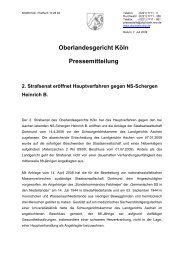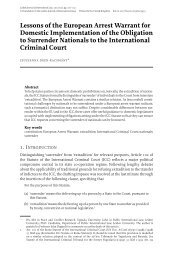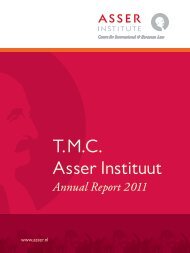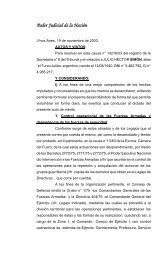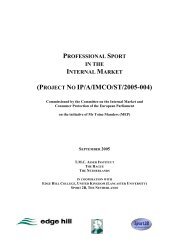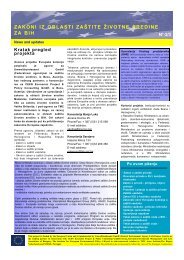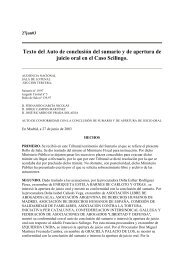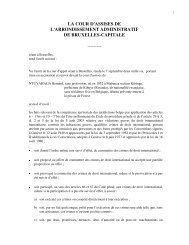Islj 2009 3-4 - TMC Asser Instituut
Islj 2009 3-4 - TMC Asser Instituut
Islj 2009 3-4 - TMC Asser Instituut
Create successful ePaper yourself
Turn your PDF publications into a flip-book with our unique Google optimized e-Paper software.
6.3.3 The Gaming Department<br />
It supervises the organisation and management of all games, oversees<br />
the management of gaming concessions, ensures that tax revenues are<br />
correct and regular and formulates directives and regulations. It also<br />
coordinates the procedures involved in granting new concessions by<br />
establishing guidelines in relation to their assignment and managing<br />
the relative public tenders.<br />
6.3.4. The Department for the Organisation and Management of<br />
Resources<br />
This office manages the human, capital, logistical and IT resources<br />
which are necessary to enable AAMS to carry out the role and tasks<br />
assigned to it. It is responsible for developing its IT system and its on<br />
line network. It defines the guidelines and procedures for managing<br />
its real estate, staff training, labour relations and collective bargaining<br />
negotiations.<br />
7. Numbers-based games<br />
7.1. Lotto and SuperEnalotto.<br />
Lotto is a popular, traditional and customary Italian game. It has the<br />
potential of developing and meeting the requirements of the changing<br />
habits and psychological motivations of Lotto players, despite its<br />
lengthy history. A number of innovations were recently introduced, to<br />
it, including automated extraction, focussed extraction, the national<br />
draw (“ruota”) and the third weekly extraction, while another brandnew<br />
feature, Instant Lotto, was added in 2006.<br />
SuperEnalotto is another game invented in 1997. It involves foretelling<br />
the first numbers extracted in the draws of Bari, Florence,<br />
Milan, Naples, Palermo and Rome. The first number extracted in the<br />
draw of Venice serves as the “joker” number.<br />
Fabulous winnings have firmly entrenched SuperEnalotto in Italy’s<br />
collective imagination, such as the amazing record of 72 million euros<br />
set in 2005. Since 2006, the fans of SuperEnalotto have been using<br />
presented with a brand-new logo, a new playing sheet and a new<br />
optional, related game: SuperStar.<br />
SuperStar is a new optional, tie-in game coupled with Super -<br />
Enalotto. A random number between one and ninety is generated by<br />
the terminal at the moment the wager is confirmed, the number<br />
becomes the winner number if it matches the first number drawn on<br />
the national Lotto draw.<br />
7.2. Lottery<br />
National lotteries are one of the oldest and most popular forms of traditional<br />
gaming in the world. They are associated with one or more<br />
historical, artistic or cultural events, or other types of local initiatives,<br />
and combine the diversion of gaming activity with the promotion of<br />
our country’s artistic and cultural resources. The most important lottery<br />
in Italy is the “Lotteria Italia”, which has been held since the<br />
1960´s and given extensive media coverage. The draw for the winners<br />
is usually held on January 6 of each year.<br />
In recent years, in line with changing lifestyles increasingly characterised<br />
by speed and immediacy, there has been a growing desire for<br />
immediate victory, regardless of the amount at stake.. This led to the<br />
creation of instant lotteries and drawings, known in Italy in the<br />
famously known name of “Gratta e vinci” (“Scratch and Win”), a title<br />
that summarises the mechanics of the game.<br />
In the year 2003, they launched a third type of lottery. Tied in with<br />
the traditional lotteries, this new form of gaming utilises telephone<br />
communications.<br />
7.3. Bingo<br />
It invlves the extraction of ninety numbers, and was introduced in<br />
Italy in 2001. It resembles the traditional “tombola” game played by<br />
Italian families from time immemorial. Bingo is played in specially<br />
equipped Bingo Halls that offer hospitality and entertainment services<br />
to promote friendly encounters and socialisation, thus making it a<br />
pleasant pastime.<br />
One unique feature of Bingo from the other games relates to the<br />
individual behaviour of the participants and the distance, in terms of<br />
both space and time, between the moment when the game is played<br />
and the moment of the winnings. Since 2005, it has been possible to<br />
play Bingo through the creation of a single “virtual bingo hall” on a<br />
national level making for extractions that produce sizeable prizes even<br />
in the smallest “real” halls.<br />
8. Games based on sports and horse racing.<br />
This activity pools betting games based on forecasting sports results<br />
are time-honoured favourites in Italian popular culture, currently distributed<br />
through a vast and widespread network of betting points<br />
connected with the Totalisator, which registers all the wagers in real<br />
time and with the utmost security.<br />
One such game goes by the name Totocalcio, which involves forecasting<br />
the outcomes of soccer matches (currently 124). From the<br />
moment it was introduced, in 1946, the game has been a fixture for all<br />
Italians, even those with less enthusiasm for soccer and less gaming<br />
ability, thus giving it a privileged place in the country’s collective<br />
imagination. Innovative elements have subsequently been introduced:<br />
the Totogol game (in which the number of goals scored in each of the<br />
games listed on the betting slip must be forecasted), plus a new game,<br />
“9”, coupled with Totocalcio.<br />
The Totip pools game (based on horse races) is one of the oldest<br />
and most traditional games, still constituting a very well known<br />
brand. The Tris bet (in which the first three finishers of a race must<br />
be forecast) is a betting outlet game, played with a betting slip and<br />
aimed primarily at public affiliates, even though its widespread use<br />
and simplicity make it suitable for all players. In 2006, further new<br />
competitions were added under the name of “Ippica Nazionale”<br />
(“National Horse Racing”).<br />
In the past, bets were viewed as illegal gambling, though, as the<br />
government placed greater attention to its practice. This paved way<br />
for laws governing these activities, starting with betting on horses.<br />
Since 2002, all bets have been placed under the control of the AAMS.<br />
Bets are placed on competitions involving Olympic sports (basketball,<br />
soccer, bicycle racing, downhill and cross-country skiing, tennis,<br />
sailing and volleyball), as well as motor sports (car and motorcycle<br />
racing) and horse races organised as part of the official programs of<br />
Italian and foreign racetracks.<br />
There are traditionally two types of betting: totaliser-based and<br />
fixed rate. In the case of totaliser betting, “pots” of winnings are divided<br />
among those who have correctly forecast all the events being bet<br />
on. With fixed-rate bets, on the other hand, the bettor is playing<br />
against the “bank”, managed by concession holders, with the outcome<br />
depending on the results of individual events or of a sequence of<br />
linked events. Winners are paid an amount equal to the wager, multiplied<br />
by the fixed rate at the moment the bet was made.<br />
Also enhancing these offers are the new betting methods which<br />
have recently been introduced in the scene: “live” bets on sports<br />
events, meaning that wagers can be laid “during” the competition,<br />
until just before its conclusion (for example, up until the last lap in a<br />
motor racing event).<br />
9. Gaming machines<br />
They originated in Italy from the 1900’s onwards, .In 2002; the Italian<br />
Parliament defined the “legal” types of machines and methods of play,<br />
also regulating the possibility of winning small sums of money.<br />
Gaming machines that do not provide winnings in money can be<br />
divided into two different categories, respectively characterised by:<br />
The ability to receive an object as a prize (crane games, draws that<br />
require skill etc...);<br />
Pure entertainment (video games and mechanical and electromechanical<br />
devices, such as billiards, table football, pinball etc...).<br />
The machines, known as “Newslot” are the only AWP machines au -<br />
thorised by the AAMS and are characterized for skill or entertainment<br />
elements combined with chance. The ongoing development of AWP<br />
machines is taking advantage of improvements in information and<br />
communications technologies in order to heighten the attraction of<br />
A RT I C L E S<br />
<strong>2009</strong>/3-4 97



